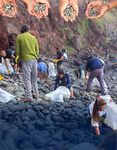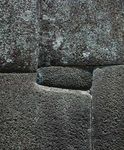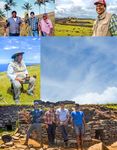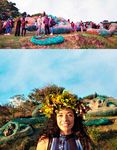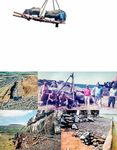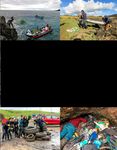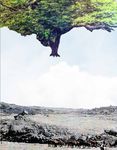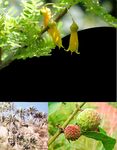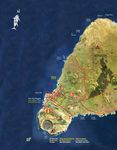Rapa Nui - Catástrofe Ecológica en
←
→
Transcripción del contenido de la página
Si su navegador no muestra la página correctamente, lea el contenido de la página a continuación
Rapa Nui
Octubre 2021
Año 13
Siglo XVII - The 17th Century
Catástrofe Ecológica en Ecological Catastrophe on
Nº 147 Rapa Nui
www.moevarua.comExposición Exposition Mana Heke
by la artista / the artist Mariana Moreno-Montiel
Una Obra que nos Invita a reflexionar A Work that Invites us to ponder
Instalación de arte que busca crear Art installation that seeks to raise
conciencia sobre el problema de la awareness about the problem of plastic
contaminación plástica en el océano. pollution in the ocean.
La obra de un gigantesco pulpo tejido con 250 metros The work of art in the form of a giant octopus, woven of 250
de tentáculos mediante cordeles, redes de pesca y otros meters of tentacles made from ropes, fishing nets and other flotsam
desechos del mar, fue inaugurado recientemente en los from the sea, was recently inaugurated in the gardens of the Easter
jardines del Museo de Isla de Pascua. Entrelazando la cultura, Island Museum. Combining culture, art and a growing awareness
el arte y la toma de conciencia sobre la contaminación plástica of the contamination of the seas by plastic, this work took more
de los mares, esta obra se llevó a cabo durante más de tres años than three years to be completed, counting with the collaboration
contando con la colaboración de la Mesa del Mar Te Mau of the Round Table of the Sea “Te Mau O Te Vaikava” and the
O Te Vaikava y de instituciones y personas que participaron institutions and persons who actively participated in the cleaning
activamente en las limpiezas costeras durante este largo proceso. of the coastal zones during this long process. The inauguration
La inauguración finalizó con la bendición sagrada de un Umu finalized with the sacred blessing of an ancestral Umu Hatu (fire
Hatu. En las noches el Heke iluminado se podrá apreciar pit). At night, the illuminated Heke can be viewed from several
desde distintos lugares de la isla hasta fines de octubre, luego se parts of the Island, until the end of October. It will then be placed
procederá a labores de mantención hasta su relanzamiento para under maintenance until its re-inauguration when the Island
la reactivación del turismo reopens and reactivates tourism.Créditos Equipo Moe Varua
Credits Team Moe Varua
Indice / Index
Pag 2-5
La Caverna Familiar
Costera de / The Katipare
Coastal Family
Cavern of
Siglo XVII - The 17th Century Pag 6-9
Rapa Nui
Catástrofe Ecológica en /
Ecological Catastrophe on
Loreto Tuki Navarrete
REVISTA MOE VARUA DE RAPA NUI
Editada por / edited by Limpieza del borde Pag 12-14
Moe Varua SpA costero y del fondo
en asociación con la / in association with marino / Cleaning
Comunidad Indígena Ma’u Henua
the Coastline and
DIRECTOR - EDITOR / EDITOR IN CHIEF the Sea floor
Helga Thieme
COLABORADORES / CONTRIBUTORS
Alfredo Tuki Paté
Betty Haoa
Cristian Moreno Pakarati
Carlos Paoa
PRODUCTORAS / PRODUCTORS
Paulina Llano Tepano
Inés Lizana
Pag 15-20
FOTOGRAFIAS / PHOTOGRAPHS
Jim Graig
Alexander Lipthay
DISEÑADORA
Silvana Sandoval
EDITOR GRAFICO / GRAPHIC EDITOR
Alexander Lipthay
TRADUCTORA/ TRANSLATOR Rafael Rapu Haoa
Terry Reagan
IMPRESORES / PRINTERS
A Impresores S.A.
PRODUCCIÓN GENERAL Exposición / Exposition Pag A-Ω
Mana Heke
Moe Varua SpA
Kainga s/n Rapa Nui-Isla de Pascua
Teléfono Rapa Nui: 56-32-2551836
Teléfono Santiago:56-2-22078442
Email: moevarua@gmail.com
1La caverna familiar costera de
The Coastal Family Cavern of
By Cristian Moreno Pakarati
Historiador / Historian
Katipare
L T
a Expedición Arqueológica Noruega a Isla de Pascua he Norwegian Archaeological Expedition to Easter
liderada por Thor Heyerdahl permaneció entre 1955 y Island, led by Thor Heyerdahl, stayed on this distant
1956 en el lejano enclave polinésico. Inicialmente los Polynesian enclave between 1955 and 1956. Initially,
noruegos pensaban que nada de valor podía obtenerse de los the Norwegians thought that there would be nothing of value
habitantes vivos, ya muy aculturados, y que la verdad sobre that could be obtained from the living inhabitants, since they were
el pasado de la isla se encontraría bajo tierra: en excavaciones already very acculturated with the Europeans and the Chileans,
efectuadas en sitios arqueológicos. Sin embargo, pronto se and that the truth of the past of the Island would be found under
darían cuenta de que los isleños contemporáneos parecían tener the earth in excavations at the archaeological sites. Nonetheless,
acceso a fuentes importantes sobre los tiempos antiguos. Esta they soon realized that the contemporary Islanders seemed to have
información era revelada siempre en forma críptica, parcial y a connection with important sources about ancient times. This
dando cuenta de que corrían gran peligro al hacer partícipes information was always revealed in a cryptic manner, fragmentary
a los extranjeros de estos conocimientos. La curiosidad de and with an awareness that there was great danger in sharing this
Heyerdahl y compañía había sido capturada, quedando knowledge with foreigners. But the curiosity of Heyerdahl and
envueltos en una telaraña cuidadosamente confeccionada por his company had been sparked and they became wrapped in a
varias familias de rapanui. web that was being carefully spun by several Rapanui families.
Uno de los focos de atracción creados cuidadosamente One of the lures that was specially created for “Señor
para el Señor Kon-Tiki (apelativo que recibía de parte de Kon-Tiki” (a nick-name that Heyerdahl received from the
los isleños) era el extraño universo paralelo de las cavernas Islanders) was the strange parallel universe of the family caverns,
familiares, que contenían supuestas reliquias ancestrales de los which supposedly contained ancestral relics from the ancestors of
antepasados de las familias Atán, Paté, Haoa, Hotu, Teao y the Atán, Paté, Haoa, Hotu, Teao and Pakarati families, among
Pakarati, entre muchas otras. El explorador noruego comenzó many others. The Norwegian explorer began to investigate. His
a indagar. Su intención era llevarse muestras de los objetos intention was to take samples of the objects found for their
encontrados para su análisis, pero, desde luego, sólo tras un analysis, but, of course, only following an agreement which would
acuerdo que también beneficiara a su guía y colaborador also benefit their Rapanui guides and collaborators. Dozens of
rapanui. Docenas de objetos de piedra y madera fueron stone and wooden objects were eventually taken to the Kon-
llevados al Museo Kon-Tiki en Oslo en 1956. Parte de esta Tiki Museum in Oslo in 1956. Part of this collection seemed
colección parecía “confirmar” sus ideas algo extravagantes de “to confirm” Heyerdahl’s rather extravagant ideas of an earlier,
una colonización primigenia desde Sudamérica. Por supuesto first colonization of the Island from South America. Naturally,
Heyerdahl no detectaría el engaño hasta mucho después y en Heyerdahl didn’t detect the ruse until much later and, in some
algunos casos jamás lo aceptaría. cases, never accepted that he had been deceived.
2Uno de los casos más interesantes fue su intento de One of the most interesting occurrences was his attempt
visitar una caverna de cuya existencia supo por Eloísa Pakarati to visit a cave which he heard about from Eloisa Pakarati-
Atamu, esposa de uno de los colaboradores rapanui de Heyerdahl, Atamu, the wife of one of his Rapanui collaborators, Enrique
Enrique Ika Tuki (llamado Ariki Paka). Era una caverna que, Ika-Tuki (called Ariki Paka). It was a cavern which, according
según ella, “pertenecía” a su tío, Santiago Pakarati Rangitaki to her, “belonged” to her uncle, Santiago Pakarati-Rangitaki
(llamado Katipare), renombrado sabio local que ya había (called Katipare), a well-known local wise man who had
colaborado con otros estudiosos de la isla en trabajos etnográficos already collaborated with other students of the Island on their
y tenía la confianza del padre Sebastián Englert. ethnographic work and who had the trust of Father Sebastian
Englert.
Al amanecer del día 28 de marzo de 1956, Heyerdahl,
salió de su campamento en Anakena conduciendo su Jeep y At dawn on March 28, 1956, Heyerdahl
acompañado por el arqueólogo chileno Eduardo Sánchez, el drove his jeep out of their camp at Anakena,
capitán del barco noruego Arne Hartmark y otro tripulante. accompanied by the Chilean archaeologist
Iban en dirección a la bahía de La Pérouse donde se encontrarían Eduardo Sánchez, the captain of the Norwegian
con Eloísa, Ariki Paka y el arqueólogo noruego Arne Skjølsvold, ship Arne Hartmark and a crew member. They
Figuras
encontradas en
Juan Nahoe
Cavernas de:
Figures found
in Caverns of: Lazaro Hotus
Pedro Atan
Juan Haoa Esteban Pakarati
además del viejo Katipare quien era el único que went toward the bay of La Perouse, where they were to meet
conocía la entrada de la cueva. Sin embargo, al up with Eloisa, Ariki Paka, the Norwegian archaeologist Arne
llegar, Skjølsvold e Ika le avisan a Heyerdahl que Skjølsvold and, also, with the elderly Katipare who was the only
el viejo Katipare se encontraba enfermo en cama y no one who knew where to find the entry to the cave. However,
podía salir, pero que había confeccionado un mapa para que su when they arrived, Skjølsvold and Ika advised Heyerdahl that old
hijo Nicolás Pakarati Tepano les mostrara el sitio. Heyerdahl, Katipare was sick in bed and couldn’t come out, but had made a
impacientado y creyendo que sería una excusa para no encontrar map so that his son, Nicolas Pakarati-Tepano, could show
nada finalmente, entró a la habitación donde se encontraba them the site. Heyerdahl, impatient and believing that
Katipare, “fingiendo una tos”. Después de bromear y reír this was just an excuse so that, after all their efforts,
acerca de la situación y el aparente arrepentimiento del they would find nothing, entered the room where
sabio rapanui, logró convencerlo de levantarse e ir a la Katipare was “pretending to have a cough”. After
caverna. El viejo Pakarati con semblante muy serio se fue joking and laughing about the situation and the
sentado en silencio en el vehículo, algo completamente seeming repentance of the old Rapanui, he was
inusual en él. able to convince him to get up and go to the
cavern. The older Pakarati, with a very serious
look about him, made the trip in the vehicle in
silence, something that was totally unusual for
him.
After driving for half an
hour over the stony road toward the
southern coastal plain, once they
had passed the area of Rano
Santiago Pakarati
KatipareTras media hora en vehículo habían dado la vuelta Raraku, Katipare spoke for the first time. The cave, he said, was not
por el pedregoso camino hacia las planicies de la costa sur. a place to hide things, but was a cave to go as a refuge “in time of
Sólo tras haber pasado la zona de Rano Raraku, Katipare war”. Pakarati assured Heyerdahl that there was “something” inside,
habló por primera vez diciendo que la cueva no era un although he himself had not gone in for many years. He added that
sitio para ocultar cosas, sino que era una cueva para ir the only time that he had entered and taken something from the cave
“en tiempos de guerra”. Pakarati aseguró que “algo” había was when he was 17 years old, shortly after an old female relative had
dentro aunque él mismo no había entrado hace muchos shown him where the entry was located. This “object” that he took
años. Agregó que la única vez que entró y tomó algo de was to help him in his fishing for the family.
la cueva fue cuando tenía 17 años y que ese “objeto” era
para ayudarlo a pescar para su familia, poco después de que Arriving at the area, shortly before the plain at Vaihu, they
una pariente anciana le había indicado la ubicación de la parked their vehicle and walked over a stony plateau to reach a vertical
entrada. cliff which dropped some 10 meters into the sea. Katipare took out
of his pocket a rope ladder which he hung on a prominent rock that
Al llegar a la zona, antes de las planicies de Vaihū, hovered over the highest point of the cliff. Then Eloisa, his niece,
estacionaron el vehículo y el grupo caminó sobre un área offered him a chicken which had been wrapped in banana leaves and
pedregosa para llegar a un acantilado vertical de unos 10 cooked in an earthen pit. Since it was Heyerdahl who wanted to see the
metros que caía hacia el mar. Katipare extrajo de un bolso cave, Katipare told him that he also should eat some. The remainder
una escalera de cuerda que colgó de una prominencia was left over a rock and immediately, old Pakarati went straight to the
rocosa que sobresalía de la parte alta del acantilado. edge of the cliff and began to sing in the ancient Rapanui language an
Luego Eloísa, su sobrina, le entregó un pollo cocido en obscure and repetitive melody which Heyerdahl described as “a song
curanto envuelto en hojas de plátano. Ya que Heyerdahl to the aku-aku”. Abruptly terminating, Katipare said that they could
era quien quería ver la cueva, Katipare le dijo que debía now go down.
comer un trozo. El sobrante fue depositado sobre una
roca y acto seguido, el viejo Pakarati se dirigió al borde The drop was complicated and the aku-aku (spirits) certainly
del acantilado y comenzó a cantar en rapanui antiguo una made it difficult. The first one down was Nicolas Pakarati, followed by
oscura y repetitiva melodía que Heyerdahl describió como the two officers of the ship and then Ariki Paka. As Heyerdahl readied
“un canto a los aku-aku”. Tras terminar abruptamente, himself to go down, Ariki Paka was coming back up very quickly and
Katipare les dijo que ya podían bajar. with his face set in terror. He claimed that he had seen something
terrible inside the cave and would not go
La bajada fue complicada y los aku-aku back under any circumstance.
ciertamente cobraron peaje. El primero en bajar fue Nicolás Rather shaken to see such
Pakarati. Le siguieron los dos oficiales del barco y luego a proud and brave man
Ariki Paka. Cuando Heyerdahl pretendía bajar, Ariki Paka return so frightened,
estaba subiendo con gran apuro y el rostro desfigurado por Heyerdahl, rather
el terror. Aseguraba que había visto algo terrible al interior d u b i o u s l y,
de la cueva y que no regresaría por ningún motivo. decided to
Algo inquieto al ver a un hombre orgulloso y muy
valiente subir tan asustado, Heyerdahl decidió bajar
dubitativamente con Skjølsvold. Katipare y Eloísa
se quedaron arriba acompañando a Ariki Paka.
La entrada a la cueva era una estrecha rotura
alargada en medio del acantilado a la que
había que entrar con los pies por delante.
Skjølsvold se quebró una costilla al entrar.
Thor
Heyerdahl
con esculturas
antiguas
with ancient
sculptures
4Juan el Brujo, Tumu y Andrés Haoa en la caverna de Juan
Una vez adentro, Nicolás Pakarati tenía descend with Skjølsvold. Katipare and Eloisa remained on the top of the
la caverna iluminada con una vela. Era de una cliff to accompany Ariki Paka. The entry to the cave was a narrow cleft in
extensión respetable pero de una bóveda baja. Había the middle of the cliff. It was necessary to enter feet first and Skjølsvold
tres tumbas en el interior: dos muy antiguas envueltas fractured a rib as he was going in.
en esteras descompuestas de totora que se deshacían
ante cualquier toque, y otra algo más nueva, aislada Once inside, Nicolas Pakarati had illuminated the cavern with
de las otras dos. Según Katipare, eran entierros de sus a candle. It was of respectable depth, but with a low ceiling. There were
parientes de hace más de cien años, de los tiempos three burials inside: two very old ones, wrapped in decomposed reed mats
pre-misionales. Junto a los dos esqueletos envueltos which fell apart at the lightest touch and another one that was newer and
en totora que yacían paralelos cerca de la entrada, set apart from the others. According to Katipare, these were burials of
había algunos bolsos tejidos de totora que tenían en some of his relatives from more than one hundred years earlier in the
su interior algunos talismanes y figuras de piedra de times before the missionaries. Together with the two skeletons wrapped
pequeño tamaño. Una figura femenina, un busto con in reeds, which were lying parallel to each other near the entry, there were
dos cabezas enfrentándose entre sí y una langosta some bags woven of reeds that contained some small talismans and stone
de piedra de estilo muy realista fueron parte del figurines inside. A female figurine, a bust with two heads facing each other
“botín” llevado por los noruegos. Katipare les había and a stone lobster carved in a very realistic style were part of the “booty”
pedido dejar una figura en la cueva y los noruegos taken by the Norwegians. Katipare had asked them to leave one figure in
cumplieron, aunque un par de años después, ésta fue the cave and they did, although, a few years later, this was removed by the
extraída por el etnólogo alemán Thomas S. Barthel. German ethnologist Thomas S. Barthel.
La historia no termina ahí, antes de su The story does not end here. Before his death, several “owners”
muerte, varios “dueños” de cavernas familiares of family caverns confessed to relatives and friends that they had
confesaron a sus familiares y amigos haber encantado “bewitched” Heyerdahl with their stories in order to sell him crafts that
a Heyerdahl con sus historias para vender artesanías they had recently made and properly aged to look antique and thus gain a
recién hechas y luego envejecidas debidamente para few dollars. However, it was due to Heyerdahl’s book
ganarse unos dólares. Gracias al libro Aku-Aku de “Aku–Aku”, published in several languages, that
Thor Heyerdahl, editado en diferentes idiomas, la isla the Island was first made known throughout
fue dada a conocer por primera vez al mundo. the world.
Eculturas pétreas de
guardianes mágicos
Stone Sculptures of
Magical Guardians
5Siglo XVII - The 17th Century
Catástrofe Ecológica en
Ecological Catastrophe on
Rapa Nui
Maderas Sagradas / Sacred woods
Antes de / Before 1650
Pittosporum
6/8 m Psydrax 2/3 m
Alcalypha - 3 m Broussonetia Coprosma - 3 m Fitchia - 4/6 m Macaranga - 15 m Myrsine - 5/8 m Psychotria Santalum 6/8 m
Alphitonia - 25/30 m 5/8 m Caesalpinia - 5/8 m Elaeocarpus - 15/20 m Paschalococos - 20/25 m Metrosideros - 10 m Premna 3/4 m 2/4 m Sapindus 8/10 m
L S
os arqueólogos Michele y Catherine Orliac, han ince 1976, the archaeologists, Michele and Catherine Orliac,
centrado, desde 1976, sus investigaciones en la have dedicated their research to the evolution of climate, the
evolución del clima, la organización territorial y cultura territorial organization and the material culture of the ancient
material de los antiguos polinesios. Desde 1988, sus trabajos Polynesians. From 1988, their work enabled them to reconstruct
han reconstruido la historia del clima y la vegetación de Rapa the history of the climate and vegetation of Rapa Nui from the time
Nui desde que arribaron los primeros habitantes hace cerca de of the arrival of the first inhabitants nearly one thousand years ago
un milenio. (Isla de Pascua, historia del pueblo rapanui, 2018) (Isla de Pascua, Historia del Pueblo Rapanui, 2018).
Sus investigaciones acerca de la flora de Rapa Nui Their research on the flora of Rapa Nui has shown that,
han demostrado que antes de 1650, crecían en la isla 23 prior to 1650, some 23 species of trees, bushes and scrub grew on
especies de árboles, matorrales y arbustos. Tres de estos árboles the Island. Three of those woody trees rose to a height of 20 meters
leñosos alcanzaban 20 metros o más y otros cinco los 10 or more, with another five reaching 10 meters. After 1650, only
metros. Después de 1650, solo quedaron 6 especies leñosas, 6 woody species remained, of which only two have survived to the
de las cuales solo dos de ellas sobrevivieron: la broussonetia o present : the broussonetia (paper mulberry) and the triumfetta
morera de papel y la triumfetta, dado que sus materias primas (burbark), since their fibrous material was
fibrosas se empleaban en la fabricación de vestuario y sogas. useful in the manufacture of
clothing and ropes.
The
61867
1640 AD
Desde el siglo
XV hasta el
Siglo XVII
Since the
fifteenth
century until
the 17th
century
N = 11978
0 20 40 60 80 100 %
Catastrofe
Maderas Sagradas / Sacred woods Ecológica
Antes de / Before 1650 Larga Sequía Después de / After 1650 Antes de
Mediados del / Before
siglo XII 1957
Ecological
Catastrophe
Long Drought
middle 12th
century
Syzygium Toromiro - 6/8 m Triumfetta Xilosma Caesalpinia Sapindus - 8/10 m Triumfetta - 3/6 m
5/8 m Thespesia 4/10 m Trema - 8/10 m 3/6 m 4/6 m 3/8 m Broussonetia - 5/8 m Thespesia - 4/10m Toromiro - 6/8 m
Excavaciones francesas efectuadas en Orongo en 1995 analyses of nearly twelve thousand pieces of charcoal with well
han indicado, gracias al análisis de doce mil trozos de carbón con defined dates recovered in the French excavations at Orongo in
fechas bien definidas, que la desaparición de los árboles, arbustos 1995 have shown that the disappearance of the trees, bushes and
y matorrales en los montes y valles fue brusca. En efecto, después scrub on the hillsides and in the valleys was abrupt. After 1650,
de 1650, los hornos de las cocinas (umu pae) ya no se calentaban the cooking pits (umu pae) were no longer heated with firewood,
quemando leña, sino principalmente pastos. La decena de otros but primarily with grass. A dozen other sites on the Island that
sitios estudiados en la isla permite llegar a las mismas conclusiones. have been studied lead to the same conclusion. Only a wide-
Solo un fenómeno natural de gran amplitud, como el cambio ranging natural phenomenon, such as climate change, is capable
climático, es capaz de producir tal catástrofe ecológica con una of producing such an ecological catastrophe with a brusque,
sequía brusca e intensa. sudden drought.
El cambio climático ha sido una de las principales causas Climate change has been one of the principal causes
de destrucción de los ecosistemas. El conjunto de fenómenos of the destruction of ecosystems. A combination of climatic
climáticos como El Niño/La Niña y los inviernos y veranos más phenomena, such as the El Niño/La Niña currents and winters
fríos que de costumbre, llevó a los climatólogos a denominar este and summers cooler than normal, have led climatologists to refer
período la Pequeña Edad de Hielo, que se prolongó entre los
7Sophora toromiro
to this period as “The Little Ice
Age”, which lasted from the 14th
to the 19th Centuries and which
caused general crises throughout
the world. Asia, China, India,
the European countries and their
colonies in America all suffered
unprecedented demographic,
social, economic and political
catastrophes. These fluctuations in
siglos XIV y XIX y que produjo una crisis the climate struck locally, mainly affecting one region at a time
general en el mundo. Asia, China, India, los países and not as is happening in the present day when the effects are
europeos y sus colonias en América, sufrieron una catástrofe being felt throughout the world at the same time.
demográfica, social, económica y política sin precedentes.
Estas fluctuaciones del clima fueron localizadas, afectando In the 17th Century, due to a notable increase in
principalmente a una región a la vez, no como en la actualidad volcanic activity, earthquakes, comets and sunspots, there were
que afecta a todo el mundo al mismo tiempo. many who speculated that these phenomena were omens of
coming catastrophes, just as must have also happened on Rapa
En el siglo XVII, debido al notable aumento de la Nui, where the Little Ice Age caused important psychological,
actividad volcánica, terremotos, cometas y manchas solares, había religious, social, economic and architectural transformations. The
muchos que especulaban con que estos fenómenos presagiaban Rapanui people, deprived of their sacred wood and, therefore, of
catástrofes, tal como debe haber sucedido también en Rapa Nui, their ships, were held prisoner on their own Island, with no hope
donde la Pequeña Edad de Hielo provocó transformaciones of setting out on new explorations or of escape. Even high seas
psicológicas, religiosas, sociales, económicas y arquitectónicas fishing was no longer possible. The gods had shown their fury by
importantes. El pueblo rapanui, privado de sus maderas sagradas destroying the trees and removing the mana (sacred power) from
y por ende de sus naves, estaba prisionero en su isla, sin ninguna the line of the kings. A reconstruction of the pantheon of gods set
esperanza de emprender exploraciones o escapar. Hasta la pesca in; cremation of the dead was abandoned; great ahu were built;
Palmera / Palm - (jubaea chilensis) Triunfetta
Photo by Eduardo Ruiz Tagle semitriloba
Hau Hau
8horticulture was adapted to the drought through
the creation of stone gardens and manavai.
en alta mar les Although much has been written about a collapse
fue impedida. Los and a lack of vision for the future among the
dioses habían mostrado su Rapanui, who supposedly had destroyed even the
furia al destruir árboles y arbustos smallest of trees, this is a myth that has no basis in
y quitarles el mana al linaje de los evidence.
reyes. Comenzó una reconstrucción
del panteón de los dioses; se abandonó la On Rapa Nui, the story of the trees and
cremación de los muertos; se construyeron bushes which disappeared has been reconstructed
grandes ahu y la horticultura se adaptó a la from analysis of pollen (male reproductive organs
sequía creando los jardines de piedra y los Alphytonia in plants) taken from dated sediments and, above
manavai. Aunque mucho se ha escrito acerca all, from carbon analysis of the charcoal which
del colapso y la poca visión de futuro de los remained in the cooking pits (umu pae) located
Rapanui, que supuestamente habrían destruido hasta el más mínimo ejemplar, near the ancient houses. All the woody plants,
este es un mito que no está basado en ningún hecho comprobado. with the exception of the giant palm Paschlococos
which came from what is today Chile in South
En Rapa Nui, los árboles y arbustos que desaparecieron, han sido America, originated from the Polynesian
reconstituidos gracias al análisis del polen (órganos reproductores masculinos de archipelagos to the west.
las plantas) provenientes de sedimentos datados y sobre todo por el análisis de
los carbones de leña extraídos de los hornos culinarios (umu pae) situados cerca The alphytonia trees, of 25 to 30 meters
de antiguas casas. Toda la flora leñosa, excepto la palmera grande Paschlococos in height, and the elaeocarpus, of 15 to 20 meters,
llegada desde Chile, provienen de los archipiélagos polinesios del Este. disappeared prior to 1650. After that only the
broussonetia, the sapindus (soapberry), the
Los árboles Alphitonia, de 25 a 30 metros y el aeocorpus de 15 a thespesia (portia tree) and the triumfetta survived.
20 metros desaparecieron antes de 1650, posteriormente solo sobrevivieron The last of the endemic toromiros disappeared
mBroussonietta, Sapindus, Thespesia y Triumfetta. Los toromiros desaparecieron from Rapa Nui in the 1950s, but have now
en Rapa Nui en los años 1950, pero desde hace unos años han vuelto a su tierra returned to their native land as the first species
natal siendo las primeras esperanzas de restablecer los paisajes arbolados de with hopes of reestablishing the tree-covered
antaño. landscapes of the past.Ana Te Pahu
© Map photo by SAG
Ana
Kakenga
Ana
Te Pora Maunga Terevaka
Ahu Akivi
Tahai
Vaitea
Puna Pau
Orongo
Vaiatare
Vinapu
Vaihu
Hanga Te´e
812Anakena
¡Ayúdanos a proteger el parque!
Ovahe
Help us to protect the park!
Te Pito Kura
Pu' o Hiro
Papa Vaka
Poike
Rano Raraku
Tongariki
Akahanga
Papa
Tataku Poki
Centros Ceremoniales más importantes de
0 1
km
2
The most important ceremonial centers of
He kona mo'a e tahi o roto i te rahi o te kona o Rapa Nui
913Limpieza del borde costero
y del fondo marino
Cleaning the Coastline
and the Sea Floor
UNA TAREA TITÁNICA EN
PLENA PANDEMIA /A TITANIC
TASK IN FULL PANDEMIA
by Flor Ayala
A E
diario, y desde hace ya más de 17 very day, over the last more than 17
meses, Uko Tongariki Tuki, Director months, Uko Tongariki Tuki, Director
de Turismo de la Municipalidad de of Tourism of the Municipality of
Rapa Nui, recorre el borde costero, camino a su Rapa Nui, walks along the edge of the coast
oficina y no deja de pensar en la dura tarea que en route to his office. He can’t get out of his
desde marzo de 2021 inició el grupo Pro Empleo mind the heavy task that, since March of
que lidera desde su dirección. Y, como también 2021, was started by a group
12lo hace día a día, siente que la arista positiva de la pandemia “Pro-Empleo” which his office directs. And, as he
fue contar con los recursos humanos, el tiempo y la does every day, he feels that the positive side of this
libertad para trabajar en el mejoramiento de un pandemia has been to be able to count on the
sinfín de espacios de la Isla, en especial en people, the time and the freedom to work on
la limpieza del borde costero y del fondo the improvements of an eternal number
marino. of places on the Island, and specially in
“En poco más de un año, the cleaning of the coastline and the
dice, hemos recolectado sobre sea floor.
10 toneladas de residuos entre “In little more than one year,”
neumáticos, plástico, vidrio, he says, “we have collected more
cuerdas, microplástico y fierro than 10 tons of rubbish, among
y otros desechos durante las which are tires, plastics, glass,
limpiezas del borde costero y del ropes, microplastics, iron and
fondo marino, una cifra récord other garbage during the cleaning
que marca un hito en la lucha expeditions of the coastline and
contra la contaminación. Este the sea floor, a record amount
programa que hoy da trabajo a más Uko Tongariki which marks a high point in the
de 700 personas, fue impulsado en fight against contamination. This
mayo de 2021 por la I. Municipalidad Director de Turismo Tourism Director program, which today gives work to
para palear los efectos económicos del more than 700 people, was started in May
cierre de la Isla y, por tanto, del descenso absoluto del turismo.” of 2021 by the Municipality to ease the economic effects of the
Tongariki Tuki nos indica que este equipo también closure of the Island with, therefore, a total loss of tourism.”
trabaja en tareas de mejoramiento de las caletas y de otras Tongariki Tuki tells that this group also works on
zonas de interés turístico, así como en la confección de carteles improvements in the fishing ports and in other areas of turistic
informativos reutilizando residuos de micro plástico y de otros interest, as well as in the construction of informative posters in
13materiales. “Estas acciones, se insertan en los ejes del Plan Amor, para
la preservación de los ecosistemas marítimos”, añade, mientras sigue
recorriendo el borde costero. Ricky Clementi, también integrante
del equipo de Pro Empleo Municipal, acota por su parte que los
efectos de la acumulación del plástico son evidentes y, agrega, si no
se hace este trabajo de recolección, “vamos a terminar teniendo más
microplástico que arena en las costas”.
Este microplástico proviene del Giro del Pacífico Sur, que
es considerado el lugar más hostil en todo el océano, cuya superficie
equivale en suma a la de USA, China y Rusia. Representa el 10% de
la superficie total de los océanos, pero aún así es una de las regiones
menos estudiadas de nuestro planeta. Este Giro del Pacífico Sur es
uno de los cinco enormes sistemas de corrientes circulares oceánicas
donde hay más de 100 mil fragmentos de microplástico por km
cuadrado que fluye en dirección Este desde el litoral de Tasmania
y Nueva Zelanda, en un largo trayecto hasta alcanzar la corriente de
Humboldt en las proximidades de las costas del sur de Chile.
La tarea es titánica. “De todo el trabajo, Tuki destacó lo
realizado en el sector de Vinapu, donde logramos retirar los restos
de un yate, además de gran cantidad de neumáticos. De hecho, a
la fecha, hemos retirado más de 4.600 kilos de neumáticos desde
las bahías de Hanga Roa y Hanga Piko. Por eso es vital esta labor,
porque no sólo generamos cercanía y respeto por el entorno, sino
también creamos conciencia de la necesidad de mantener a nuestra
Isla limpia, para preservar el medio ambiente y entregarla sustentable
a las próximas generaciones”, termina diciendo Uko Tongariki Tuki
mientras recorre el borde costero camino a su oficina en completa
soledad, porque los turistas hace ya 17 meses que no están.
which they reutilize remains of microplastics and other materials.
“These activities are part of the “Plan Amor” for the conservation
of the marine ecosystems”, he adds as he continues his walk. Ricky
Clementi, also a member of the “Pro-Empleo Municipal” team,
notes, on his part, that the effects of accumulation of plastic are
evident and adds that, if this job of collection isn’t done, “we are
going to end up with more microplastic than sand on the coasts.”
This microplastic comes from the South Pacific Gyre,
which is considered the most hostile place in the entire ocean, with
a surface area that is as big as the USA, China and Russia combined.
It represents 10% of the total surface area of the oceans, but, even so,
it is one of the least studied regions on our planet. This South Pacific
Gyre is one of the five large systems of circular oceanic currents
where there are more than 100 thousand fragments of microplastic
per square km. This current flows from the east from the coasts of
Tasmania and New Zealand, on a long path until it meets up with
the Humboldt current near the southern coast of Chile.
It is a titanic task. Among all their work, Tuki makes
special note of that done in the sector of Vinapu, “where we were
able to remove the remains of a yacht, as well as a large number
of tires. Actually, to date, we have removed more than 4,600 kilos
of tires from the bays of Hanga Roa and Hanga Piko. This is the
reason that this work is vital. Not only are we getting the people
closer to and with more respect for the environment, but we are
also creating awareness of the need to maintain our Island clean, to
preserve the environment and pass it on in a sustainable form to the
coming generations,” finishes Uko Tongariki Tuki, as he walks along
the coast toward his office in almost complete solitude, because it’s
already been 17 months since there have been any tourists.
14Testimonio del Pasado
Rafael Rapu Haoa Testimony
from the
Past
R afael Rapu Haoa, 74 años, hijo de Elias Rapu Tuki y
Reina Haoa. Por sus venas fluye sangre isleña y escocesa
proveniente de su abuelo materno Lachlan Mc Kinnon,
empleado de la Compañía Williamson & Balfour en 1918, quién
tuvo 3 hijos con su abuela Magdalena Haoa Araki durante su
R
afael Rapu-Haoa, 74 years old, son of Elias Rapu-Tuki
and Reina Haoa. In his veins run both Island blood and
Scottish, from his maternal grandfather Lachlan McKin-
non, an employee of the Williamson & Balfour Company in the
early 20th Century, who had 3 children with his grandmother,
estadía en la isla. Además de escultor, Rafael Rapu lleva más Magdalena Haoa-Araki, during his time on the Island. In addi-
de 52 años como Conservador y Restaurador de casi todos los tion to being a sculptor, Rafael Rapu has more than 50 years as
monumentos líticos de Isla de Pascua. an archaeological photographer, conservationist and restorer of
“Comencé en 1968, a los 21 años, durante la segunda almost all the stone monuments on Easter Island.
visita a la isla del antropólogo e investigador en arqueología “I began in 1968, at 21 years of age, during the second
William Mulloy para realizar investigaciones arqueológicas en trip that the anthropologist William Mulloy made to the Island
Tahai y en Anakena. Yo quería trabajar con él en restauración (on his own) to do archaeological research at Tahai and Anakena.
arqueológica y me ofrecí como voluntario aunque no tenían plata I wanted to work with him in archaeological restoration and offe-
para pagarme. Recuerdo que en esos tiempos, los principales red as a volunteer since he had no money to pay me. I recall that
restauradores de Mulloy fueron Germán Hotu, Juan Haoa, in those times Mulloy’s principal restorers were German Hotu,
15Andrés y Victor Riroroko, yo era el más joven. Como Mulloy Juan Haoa, Andres and Victor Riroroko. I was the youngest.
había traído un completo equipo fotográfico con 3 trípodes, Since Mulloy had brought with him complete photography equi-
4 cámaras y un laboratorio, él me propuso estudiar fotografía pment with 3 tripods, 4 cameras and a laboratory, he suggested
con el profesor Herbel Pownall del equipo de Mulloy. Al año y to me that I study photography with Professor Herbert Pownall, a
medio me especialicé como técnico en fotografía arqueológica. member of his team. A year and a half later, I began to specialize
Claro que continué trabajando como aprendiz de excavaciones as a technician for archaeological photography. Of course, I con-
y restauraciones de muchos otros arqueólogos que realizaron tinued as an apprentice in the excavations and restorations that
investigaciones en la isla.” many other archaeologists were doing on the Island.
“Después de los trabajos de restauración de los Ahu Following the restoration of Ahu Ko te Riku, Ahu Tahai
Kote Riku, Tahai y Vai Uri en los centros ceremoniales de Tahai y and Ahu Vai Uri at the ceremonial center of Tahai and that of
Anakena entre 1968 y 1978, la isla atrajo a muchos arqueólogos y Ahu Nau Nau at Anakena, between 1968 and 1978, the Island
científicos en general para realizar investigaciones en las que fui attracted many archaeologists and scientists in general to do re-
invitado a participar y hasta el día de hoy estoy en esto.” search. I was invited to participate and am still in this to this day.”
Koro Rafael Rafael Rapu, fotógrafo en arqueologia
Rafael Escultor/ Sculptor
junto al equipo photographer in archeology
Mulloy
together with
the Mulloy team
Para Rafael Rapu, su vida ha sido un eterno aprendizaje. For Rafael Rapu, his life has been an on-going educa-
“Antes de las primeras investigaciones arqueológicas nadie sabía tion. “Before the first archaeological investigation, no one knew
nada, ni los mismos rapanui. Los arqueólogos entrevistaban a los anything, not even the Rapanui themselves. The archaeologists
locales y transcribían sus relatos, pero después se dieron cuenta would interview the people and transcribe their stories, but they
que los pascuenses eran muy dados a confundir mito con realidad soon realized that the natives were very given to confuse myth
inventando explicaciones. Rafael se ríe hoy al recordar que fue with reality and would invent explanations.” Rafael laughs today
su tío Joaquín Rapu, junto con Daniel Tepano e Hipólito Ika, when he recalls that it was his uncle Joaquin Rapu, with Daniel
quienes les contaron a los extranjeros que los moai del Ahu Tepano and Hipolito Ika, who told the foreigners that the 7 moai
Akivi representaban a los 7 exploradores que miraban hacia (statues) at Ahu Akivi represented the 7 explorers who were loo-
Hiva, su lugar de origen. Joaquín se justificaba diciendo que king back to Hiva, their native land. Joaquin justified himself
lo había soñado. “Cada Ahu con sus Moai mira hacia la aldea by saying that he dreamed it. Each ahu (platform) with its moai
a la cual protegen y le recuerdan el ordenamiento sagrado a sus look toward the village which they protect and remind the in-
habitantes.” Otra historia recordada por Rafael fue la inventada habitants of the sacred order of the land. Another story recalled
por Nemo Briones, cuñado de Joaquín Rapu, quién llegó a la by Rafael was that invented by Nemo Briones, brother-in-law
isla a trabajar como guía turístico. Ante la frecuente pregunta de of Joaquin Rapu, who arrived on the Island from Valparaiso to
cómo se transportaban los moai, éste contó que vino un barco work as a tourist guide. “He was often asked how the moai had
de Australia y trajo 2 elefantes blancos que luego transportaron been transported, so he began to tell people that a ship had come
los moai. También en Orongo hay una piedra mítica con una from Australia, bringing 2 elephants which were used to move the
pequeña figura de un moai y hasta hoy algunos relatan que sobre moai. Also, in Orongo, there is a legendary stone with a small
ella nacían las guaguas”. “Nada que ver”, nos dice Rafael. figure of a moai and, even today, some say that the babies were
born on this stone. Not true at all!”
16Anakena Rapu Tepano & Reina Haoa Reina Haoa,
Madre de
Mother of
Rafael Rapu
Lachlan Mc Kinnon, abuelo materno de
maternal grandfather of, Rafael
Nietos de
grandchildren of
Rafael Rapu:
Añe, Rafael,
Carlos y Marcelo
Rafael Rapu nació bajo la administración de la Rafael Rapu was born when the Island was under the
hacienda ovejera Williamson & Balfour (1905 -1953). “No había administration of the English sheep company Williamson & Bal-
discotecas, cigarros o alcohol, las únicas entretenciones eran los four (1903 -1953). “There were no discotheques, cigarettes or
caballos, la pesca, el buceo y el futbol. Los jóvenes íbamos los alcohol. Our only entertainments were horses, fishing, diving
fines de semana con un picnic a pololear a la playa de Ovahe and soccer football. The young people would go on the weekend
porque era más privada que Anakena. Yo iba con Diana Tepano to the beach at Ovahe, because it was more private than Anakena.
Hito, con la cual me casé y tuvimos 4 hijas: Mariki, Anakena, I went with Diana Tepano-Hito, whom I married, and we had 4
Blanca y Lory. La isla era muy pobre, mis primeros trabajos children: Mariki, Anakena, Blanca and Lory. The Island was very
fueron en Vaitea donde participaba una vez al año en la esquila de poor. My first jobs were at Vaitea where, once a year, I worked on
lana. Era el único trabajo remunerado que había. Después llegó the sheep shearing. It was the only paid work that was available.
Kevin Kostner para filmar su película y cambió nuestra situación Then, Kevin Costner arrived to film his movie and our economic
económica.” situation changed. There was a lot of money circulating on the
A partir del año 1953 caduca el contrato de arriendo Island, as never before. For many Islanders, those were two years
entre el Estado chileno y la Williamson & Balfour, quedando la isla of consumption with a great cultural change, when we lost many
bajo la tuición exclusiva de la Armada. Rafael Rapu comenta que old customs. Another negative effect was the arrival of cocaine.
el siguiente trabajo lo obtuvo del Geográfico Militar con el objeto Today that poison is a terrible plague, just like alcoholism. The
de levantar los puntos geográficos más elevados de la isla. Esta filming was a very bad influence for our young people.”
época fueron años de percepción de falta de libertad, de azotes y In 1953, the government of Chile rescinded the lease of
escarnios públicos a habitantes nativos y fugas de estos a otras islas the Island to Williamson & Balfour and placed it under the ex-
Toncho Rapu movimiento de Roca en la restauración de
Nieto de Rafael rock movement in the restoration of
Rafael's grandson
Ahu Tongariki
17
Diana TepanoTraslado de Moai al
Transfer of the Moai to
Ahu Tongariki clusive tuition of the Chilean Navy. Rafael Rapu
comments that his next job was with the Chilean
Military Geographic Institute as they were map-
ping the highest geographic points of the Island.
This period was marked by a perception of a lack
of freedom, of whippings and public shaming of
del the native people, which led to attempts of escape
Pa c í f i c o. to other islands in the Pacific. The growing discon-
El creciente descontento tent in respect to their living conditions was noted by a
respecto a sus condiciones de vida fue young native schoolteacher, who had been educated on the
recogido por un joven profesor, educado en el continente, mainland and recently returned to the Island. He was none less
convirtiéndose en líder de la rebelión de 1964-65 que dio paso than Alfonso Rapu-Haoa, Rafael’s older brother, who became the
a la administración civil en 1966, otorgándose a los isleños los leader of the Rapanui rebellion of 1964. “I always went with him
mismos derechos ciudadanos que al resto del país. El líder de este when he had to escape from the soldiers who tried to arrest him,”
cambio fue Alfonso Rapu Haoa, hermano mayor de Rafael. “Yo notes Rafael. “This event changed the history of the Island. The
siempre lo acompañaba”… nos comenta… military administration was lifted in 1966, giving way to civil
Mi vida la he dedicado a criar a mis hijos y después government, giving the Islanders the same constitutional rights as
a mis nietos. Con mi señora tuvimos 12 años de felicidad y all the citizens of the country.“
después cayó enferma, sin mejoría posible. Mis dos hijas mayores “My life has been dedicated to raising my children and
tuvieron hijos muy jóvenes y decidieron irse de la isla. Como then my grandchildren. With my wife, we had 12 happy years,
vivíamos todos juntos, Ana se fue sin avisar a Santiago y Mariki but then she fell sick without any possibility of recovery. My two
a Tahiti, dejándome ambas a cargo de sus hijos. Yo me encariñé oldest daughters lived with us and had children very young. They
mucho con ellos y dediqué mis años jóvenes a criarlos. Cuando both decided to leave the Island. Ana went to Santiago without
me invitaron a EEUU a una conferencia sobre prehistoria me saying a word to anyone, and Mariki to Tahiti, leaving me in
ofrecieron quedarme 3 años para estudiar inglés. No me quedé charge of their little children. I became very fond of them and
porque mi familia era más importante. Hoy mi orgullo son mis dedicated my younger years to raising them. When I went on an
Restauración Plataforma
platform restoration
Ahu Tongariki
18cinco nietos, casi todos profesionales. El invitation to the USA for a conference on
mayor es Rafael Simón Rapu Rapu, hijo pre-history, I was given an offer to stay for
de Mariki, recibido como arqueólogo 3 years to learn English. I didn’t, because
y Pedro José Rapu, hijo de Ana, que my family was more important. Today
Restauración de casa en / Restoration of house in Orongo
se recibió como constructor. Después my pride and joy are my 5 grandchildren,
viene Muti Pont, hija de Anakena Rapu almost all professionals. The oldest is Ra-
Tepano, quien estudió finanzas, Toncho fael Simon Rapu-Rapu, Mariki’s son who
Rapu, hijo de Ana, y Pichu Muñoz graduated as an archaeologist. Next is
Rapu. Pedro Jose Rapu, Ana’s son who now has
Rafael Rapu siente que ha his diploma in construction. And then
cumplido su tarea, se ha dado el tiempo there are Muti Pont, son of Anakena who
para conocer cada piedra en su querida studied finance, and Toncho Rapu, son
isla….“las generaciones futuras son of Ana and Pichu Muñoz. I feel that my
ahora los responsables de mantener el job is done, both with my children and
patrimonio en Rapa Nui y perpetuarlo with the Island. I took the time to get to
con el resto de la historia.” Actualmente know every stone of my beloved Island.
supervisa la restauración de una de las Now the future generations have the res-
casas de Orongo que se derrumbó en el ponsibility of maintaining the heritage of
mes de septiembre pasado debido a la Rapa Nui and perpetuating it along with
erosión. “A mis dos nietos los invité a the rest of its history. I invited two of my
practicar conmigo, junto a otros jóvenes grandchildren to work with me at Oron-
como la arqueóloga Merahi Atan y a go, together with other young people,
Javier Manutomatoma Targarana. such as the archaeologist Merahi Atan and
Ahora les toca a ellos continuar mi Javier Manutomatoma-Targarana. They
trabajo. Yo ya no puedo caminar y me have to continue my work. I can no lon-
quiero ir a descansar.” ger walk and I want to go to my rest.”
19Restauración realizadas por Restoration carried out by Rafael Rapu
1967 / 70 Ahu Koteriku, Ahu Tahai & Ahu Vai Uri. Centro Ceremonial Tahai Ceremonial Center.
1968 Prospecciones en / prospecting in Rano Kau con / with Patrick McCoy.
1972 Ahu Hanga Kioe.
1975 / 76 Ahu Huri a Urenga.
1975 / 76 Casas en centro ceremonial / Houses in ceremonial center Orongo.
1978 Ahu Okava (ubicado en terreno particular del Alcalde / located on the Mayor's private land).
1978 Ahu Nau Nau en / in Anakena.
1982 / 83 Ahu Kopeka Ta'e ati (frente cancha de futbol / front of the soccer field).
1997 / 99 Ahu Tataku Vave o / or Ahu Hanga Riata en / in Hanga Piko.
2002 Trabajos preventivos en / Preventive work in Hanga Tetenga & Hanga Te'e en / in Vaihu.
2003 Restauración Muro de 11 m x 50 m en / Wall restoration of 11 m x 50 m in Runga a Va'e
donde cayó un Moai al Mar / where a Moai fell into the Sea.
2003 Restauración final y colocación poros en ala norte del / Final restoration and pore placement
in the north wing of the Ahu Tongariki.
2004 Rescate de Moai caído al mar en / Moai rescue fallen into the sea in Hanga Nui.
2004 / 06 Aplicación de químicos a los Moais en / Chemical application to Moai's in Tongariki
(proyecto / proyect Japón-UNESCO)
2014 Rescate de Moai en / Moai rescue in Pakaia al norte de / to the north of Vaihu.
2017 Salbataje de un Moai en / Moai rescue in Pahahatea en / in Hanga Nui.
2018 / 19 Restauración muro de contención del / Retaining wall restoration Ahu Ura Uranga o Te Mahina.
2020 / 21 Última restauración de una casa en centro ceremonial / Last restoration of a house in
ceremonial center Orongo.
Ahu
Ura Uranga
o Te Mahina
20Heke Pulpo Octopus
Símbolo de un Mapa de la Navegación
Symbol of a Navigational Chart
Los pulpos y calamares son especies marinas The octopus and the squid are marine species with
con capacidades sensoriales que superan sensorial abilities that are far superior to those of
ampliamente a las de peces y crustáceos. fish and crustaceans. Nonetheless, they have life
Sin embargo, poseen ciclos de vida muy cycles that are very short, rarely extending for
cortos que raramente se extienden por más more than two years. In spite of their fleeting
de dos años. A pesar de su fugaz existencia existence on an individual level, their importance
a nivel individual, su importancia como as a group of species which have persisted over
grupo de especies ha persistido en el tiempo, time have transformed them into sacred creatures
transformándose en criaturas sagradas que occupying an important role within the rituals and
han ocupado un lugar importante en rituales mythology of Polynesia, with legends referring
y mitología de la Polinesia, con historias to them as a guardian, as a god
referidas a un guardián, un dios of the sea and fishing or
del mar y de la pesca, o a un as a symbol of
símbolo de navegación. navigation.
Mariana Moreno
MontielISLA DE PASCUA
EASTER ISLAND
Isla de origen volcánico que se eleva a 3.000 metros sobre
el fondo oceánico. Su superficie basal tiene forma de
trapecio y es 50 veces su área emergida. En cada vértice,
producto de erupciones volcánicas, se localiza un volcán
principal: el Poike al este (3 millones de años), el Rano
Kau en el sur (2 millones de años) y el Maunga Terevaka
en el norte (200.000 años). Además existen cerca de 104
centros eruptivos en forma de cráteres, conos y domos.
An island of volcanic origin, which rises 3.000 meters above
the floor of the sea. Its base has trapezoid form and covers
an area 50 times as large as the area above the surface of the
water. In each corner, as a result of volcanic eruptions, there is
a major volcano: Poike to the north-east (3 million years old),
Rano Kau in the south (2 million years old), and Terevaka in
the north-west (200.000 years old). There are also another
104 eruptive centers in the form of craters, cones and domes.
Meses cálidos / Warmest months: January and February
Mes lluvioso / Wettest: May
Idioma / Language: Rapa Nui, Spanish
Moneda / Currency: Chilean peso, dólar and euro
Hospital / Hospital: Simon Paoa s/n, Phone 2100215
Policia / Police (emergencies): Phone 133
Turist information: Sernatur, Tu’u Maheke street, M-F 8:30
am - 1:00 pm
Banco / Bank: Banco Estado, Tu’u Maheke street, M-F 8:00
am - 1:00 pm
Correo / Post office: Te pito o te henua street,
M-F 9:00 am - 1:00 pm, 4:00 pm - 6:00 pm
Ubicación / Location: 27º 09’ Lat. - 109º 26’ W Long.
Distancia / Distance: - Chile: 3.700 kms.
Distancia / Distance: - Tahiti: 4.000 kms.
Dimensión / Dimensions: 24 kms. x 16 kms. x 12 kms.
Superficie / Area: 166 kms2.
Altura / Height maximun: 550 ms. above sea level
Habitantes / Inhabitants: 7.750 (Censo 2017)
Clima / Climate: Subtropical
Meses frios / Coolest months: July and August
Temperatura / Temperature: Summer: 15ºC - 28ºC /
Winter: 14ºC - 22ºC
NA POLINE
IGE SI
ND
CA
I
COM IDAD
MA
Patrocinadores
U HENUA
UN
/ Sponsors:
@moeVaruaOficial www.moevarua.com R A PA N U ITambién puede leer
